1998 GMC SIERRA check engine light
[x] Cancel search: check engine lightPage 195 of 452
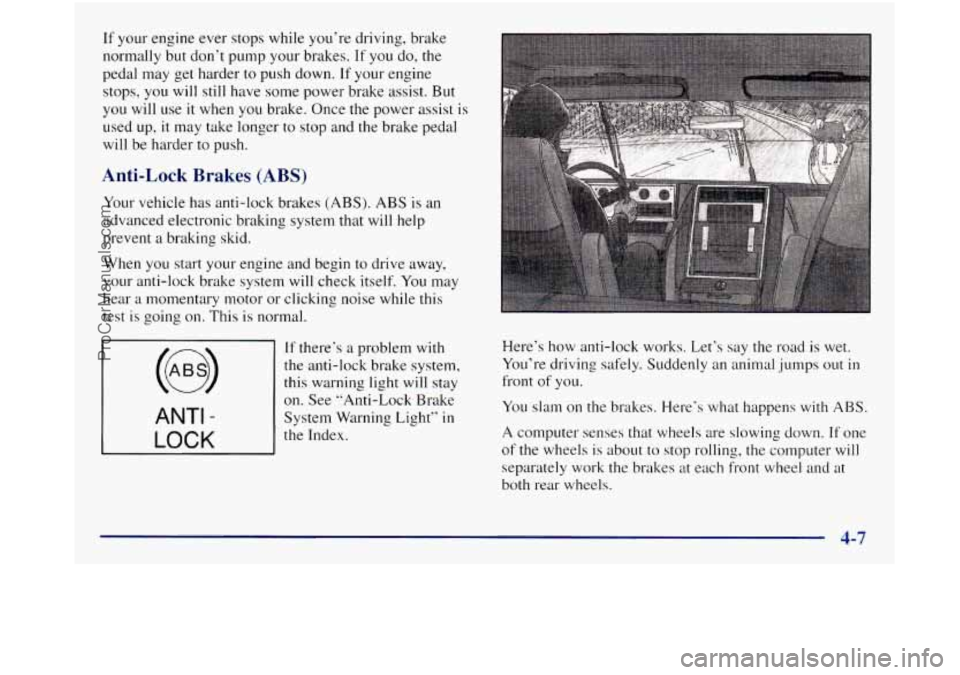
If your engine ever stops while you’re driving, brake
normally but don’t pump your brakes.
If you do, the
pedal may get harder to push down. If your engine
stops, you will still have some power brake assist. But
you will use it when you brake. Once the power assist is
used up, it may take longer to stop and the brake pedal
will be harder to push.
Anti-Lock Brakes (ABS)
Your vehicle has anti-lock brakes (ABS). ABS is an
advanced electronic braking system that will help
prevent a braking skid.
When you start your engine and begin
to drive away,
your anti-lock brake system will check itself. You may
hear
a momentary motor or clicking noise while this
test is going on. This is normal.
(@!
ANTI -
If there’s a problem with
the anti-lock brake system,
this warning light will stay
on. See “Anti-Lock Brake
System Warning Light”
in
I LOCK I the Index. Here’s how
anti-lock works. Let’s say the road
is wet.
You’re driving safely. Suddenly an animal jumps out
in
front of you.
You slam
on the brakes. Here’s what happens with ABS.
A computer senses that wheels are slowing down. If one
of the wheels is about to stop rolling, the computer will
separately work the brakes at each front wheel and at
both rear wheels.
4-7
ProCarManuals.com
Page 214 of 452
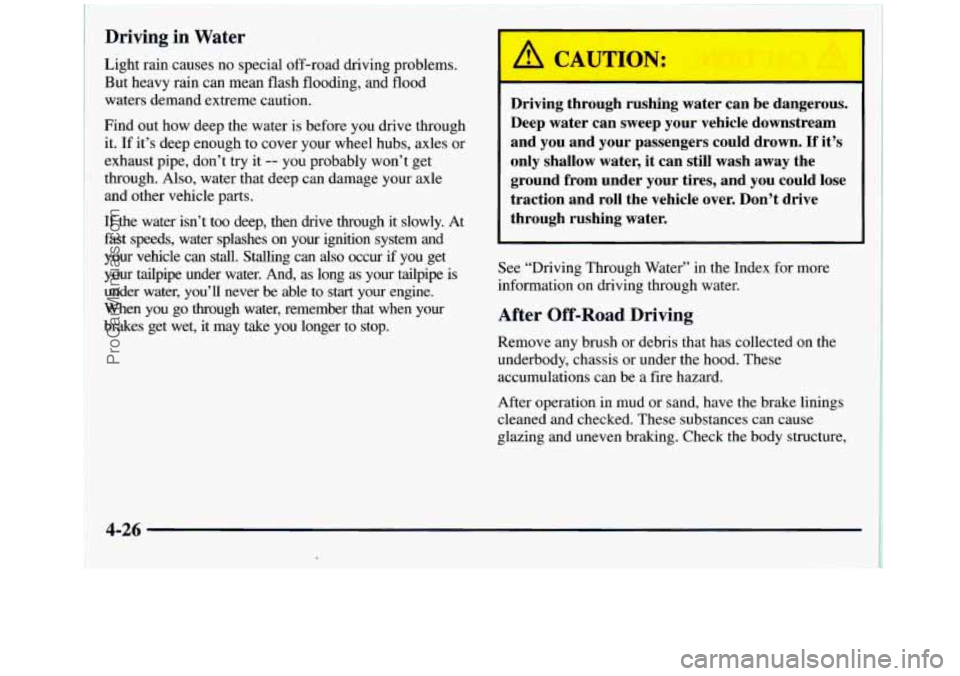
__ ~~~~~ ~ ~~ ~ ~ ~ . _~_
Driving in Water
Light rain causes no special off-road driving problems.
But heavy rain can mean flash flooding, and flood
waters demand extreme caution.
Find out how deep the water is before
you drive through
it. If it’s deep enough to cover your wheel hubs, axles or
exhaust pipe, don’t try it
-- you probably won’t get
through. Also, water that deep can damage your axle
and other vehicle parts.
If the water isn’t too deep, then drive through it slowly. \
At
fast speeds, water splashes on your ignition system and
your vehicle can stall. Stalling can also occur
if you get
your tailpipe under water. And, as long as your tailpipe is
under water, you’ll never
be able to start your engine.
When you
go through water, remember that when your
brakes get wet,
it may take you longer to stop.
.
Driving through rushing water can be dangerous.
Deep water can sweep your vehicle downstream
and you and your passengers could drown. If it’s
only shallow water, it can still wash away the
ground from under your tires, and you could lose
traction and roll the vehicle over. Don’t drive
through rushing water.
See “Driving Through Water’’ in the Index for more
information on driving through water.
After Off-Road Driving
Remove any brush or debris that has collected on the
underbody, chassis or under the hood. These
accumulations can be a fire hazard.
After operation in mud or sand, have the brake linings
cleaned and checked. These substances can cause
glazing and uneven braking. Check the body structure,
4-26
ProCarManuals.com
Page 228 of 452
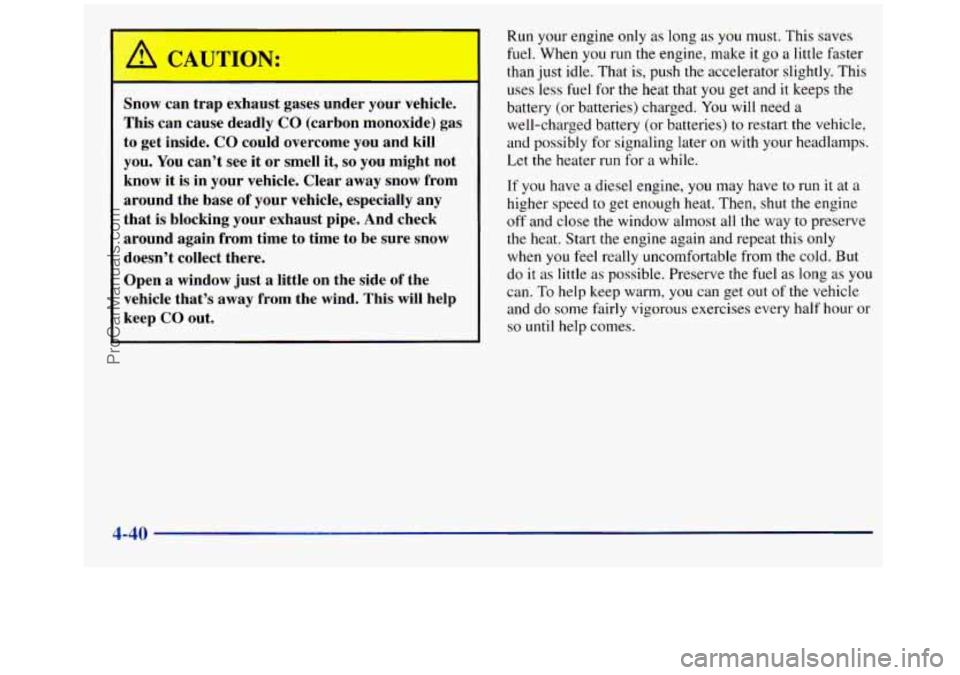
Snow can trap exhaust gases under your vehicle.
This can cause deadly CO (carbon monoxide) gas
to get inside.
CO could overcome you and kill
you.
You can’t see it or smell it, so you might not
know it is
in your vehicle. Clear away snow from
around the base
of your vehicle, especially any
that is blocking your exhaust pipe. And check
around again from time to time to be sure snow
doesn’t collect there.
Open
a window just a little on the side of the
vehicle
that’s away from the wind. This will help
keep
CO out.
Run your engine only as long as you must. This saves
fuel. When you run
the engine, make it go a little faster
than just idle. That is, push the accelerator slightly. This
uses less fuel for the heat that you get and it keeps
the
battery (or batteries) charged. You will need a
well-charged battery
(or batteries) to restart the vehicle,
and possibly for signaling later on with your headlamps.
Let the heater run for a while.
If you have a diesel engine, you may have to run it at a
higher speed to get enough heat. Then, shut the engine
off and close the window almost all the way to preserve
the heat. Start the engine again and repeat this only
when you feel really uncomfortable from the cold. But
do it
as little as possible. Preserve the fuel as long as you
can.
To help keep warm, you can get out of the vehicle
and do some fairly vigorous exercises every half hour or
so until help comes.
4-40
ProCarManuals.com
Page 257 of 452

I
Using a match near a battery can cause battery
gas to explode. People have been hurt doing this,
and some have been blinded. Use a flashlight
if
you need more light.
Be sure the batteries have enough water. You
don’t need to add water to the ACDelco
Freedom@ battery (or batteries) installed in
every new
GM vehicle. But if a battery has filler
caps, be sure the right amount of fluid is there.
If
it is low, add water to take care of that first. If
you don’t, explosive gas could be present.
Battery fluid contains acid that can burn you.
Don’t get it on you.
If you accidentally get it in
your eyes or on your skin, flush the place with
water and get medical help immediately.
5. Check that the jumper cables don’t have loose or
missing insulation.
If they do, you could get a shock.
The vehicles could be damaged too.
Before you connect the cables, here are some
basic things
you should know. Positive (+) will
go to positive
(+) and negative (-) will go to a
metal engine part. Don’t connect positive
(+) to
negative
(-) or you’ll get a short that would
damage the battery and maybe other parts
too.
On vehicles equipped with dual batteries, make any
battery connections
to the primary battery located on
the passenger’s side of the vehicle.
Fans or other moving engine parts can injure you
badly. Keep your hands
away from moving parts
once the engine is running.
5-5
ProCarManuals.com
Page 364 of 452

Fuse/Circuit Breaker Usage
20
21
22
23
24
A
B
PRNDL, Automatic Transmission,
Speedometer, Check Gages
Warning Light
Security/Steering
Not Used
Not Used
Front Axle,
4WD Indicator Lamp,
TP2 Relay (Gasoline Engine)
Power Door Lock, Six-Way Power Seat, Keyless Entry Module
Power Windows
Underhood Fuse/Relay Center
The underhood fusehelay center is located in the rear of
the engine compartment near the brake fluid reservoir.
Move the retainer clips
for the cover to access the
fuse block.
You can remove fuses with a fuse extractor. The fuse
extractor
is mounted to the interior fuse block. TO
remove fuses
if you don’t have a fuse extractor, hold the
end of the fuse between your thumb and index finger
and pull straight out.
6-74
ProCarManuals.com
Page 411 of 452
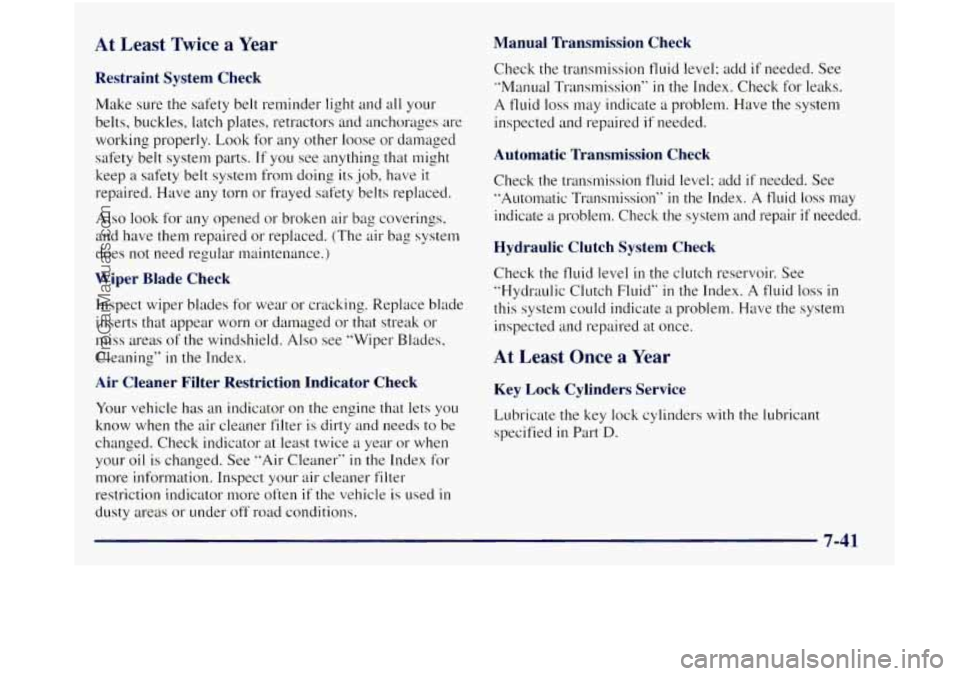
At Least Twice a Year Manual Transmission Check
Restraint System Check
Make sure the safety belt reminder light and all your
belts, buckles, latch plates, retractors and anchorages are
working properly. Look
for any other loose or damaged
safety belt system parts.
If you see anything that might
keep a safety belt system from doing its
job, ha\:e it
repaired. Have any torn or frayed safety belts replaced.
Also look for any opened or broken
air bag coverings,
and have them repaired or replaced. (The air
bag system
does
not need regular maintenance.)
Wiper Blade Check
Inspect wiper blades for wear or cracking. Replace blade
inserts that appear worn
or damaged or that streak or
miss areas
of the windshield. Also see "Wiper Blactes,
Cleaning"
in the Index.
Air Cleaner Filter Restriction Indicator Check
Your vehicle has an indicator on the engine that lets you
know when the air cleaner filter
is dirty and needs to be
changed. Check indicator at least twice
a year or when
your
oil is changed. See "Air Cleaner" in the Index for
more information. Inspect your air cleaner filter
restriction indicator more often
if the vehicle is used in
dusty areas or under off road conditions. Check the transmission fluid
level; add
if needed. See
"Manual Transmission"
in the Index. Check for leaks.
A fluid loss may indicate a problem. Have the system
inspected and repaired
if needed.
Automatic Transmission Check
Check the transmission fluid level: add if needed. See
"Automatic Transmission"
in the Index. A fluid loss may
indicate a problem. Check the system and repair
if needed.
Hydraulic Clutch System Check
Check the fluid level in the clutch reservoir. See
"Hydraulic Clutch Fluid"
in the Index. A fluid loss in
this system could indicate a problem. Have the system
inspected and repaired at once.
At Least Once a Year
Key Lock Cylinders Service
Lubricate the key lock cylinders with the lubricant
specified
in Part D.
7-41
ProCarManuals.com
Page 435 of 452

Section 9 Index
Accessory Power Outlet ......................... 2-59
AirBag ....................................... 1-23
Adding Equipment
............................ 1-3 1
How Does it Restrain .......................... 1-28
How it Works ................................ 1 -26
Location .................................... 1-26
Readiness Light ......................... 1.25, 2.65
What Makes it Inflate .......................... 1-27
What Will You See After
it Inflates ............... 1-28
When Should it Inflate ......................... 1-27
Air Bag
Off Light .......................... 1.58. 2.65
Air Cleaner
.................................... 6- 18
Air Cleaner Filter Restriction Indicator Check ........ 7-41
Air Conditioning ............................ 3.3. 3.4
Air Conditionillg Refrigerants ..................... 6-79
Alignment and Balance. Tire
...................... 6-59
Antenna
...................................... 3-26
Antifreeze
........................... 6-28.6-79.7-46
Anti-Lock Brake System Warning Light
................ 2.68. 4.7
Brakes ...................................... 4-7
Appearance Care
............................... 6-6 I
Adding Equipment to the Outside of Your Vehicle ...... 6-3
Servicing
................................... 1-30
Aluminum Wheels. Cleaning ...................... 6-67
Appearance Care and Materials .................... 6-69
Arbitration Program .............................. 8-9
Armrest Storage Compartment
.................... 2-56
Audio Equipment. Adding
........................ 3-24
Audio System
.................................. 3-7
Automatic Transmission
Check
...................................... 7-41
Fluid
.................................. 6-21. 7-47
Operation ................................... 2-15
Park Mechanism Check
........................ 7-43
Starting Your Engine
.......................... 2-12
Axle. Front
............................... 6-27. 7-47
Axle. Locking Rear
............................. 2-32
Axle. Rear
............................... 6-26. 7-47
Ashtrays ...................................... 2-58
Battery
...................................... 6-39
Jump Starting
................................. 5-3
Warnings ................................ 5-3. 5-5
BBB Auto Line ................................. 8-9
Better Business Bureau Mediation ................... 8-9
Blizzard. Driving
In ............................. 4-38
Replacement.
Keyless Entry ..................... 2-8
9-1
ProCarManuals.com
Page 443 of 452
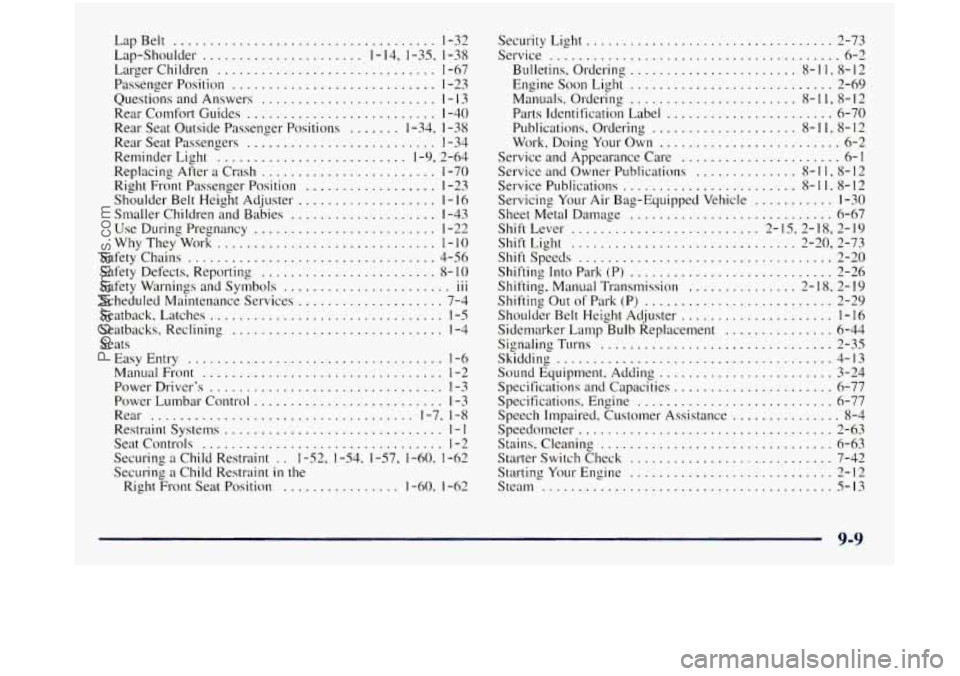
LapBelt .................................... 1-32
Lap-Shoulder
...................... 1.14. 1.35. 1-38
Larger Children
.............................. 1-67
Passenger Position
............................ 1-23
Questions and Answers
........................ 1 . I3
Rear Comfort Guides .......................... 1-40
Rear Seat Outside Passenger Positions ....... 1.34. 1-38
Rear Seat Passengers
.......................... 1-34
Reminder Light .......................... 1.9. 2.64
Replacing After a Crash ........................ 1-70
Right Front Passenger Position
.................. 1-23
Smaller Children and Babies
.................... 1-43
Use During Pregnancy ......................... 1.2 2
Safety Chains
.................................. 4-56
Safety Defects. Reporting
........................ 8- IO
Safety Warnings and Symbols ....................... 111
Scheduled Maintenance Services .................... 7-4
Seatback. Latches
................................ 1-5
Seatbacks. Reclining ............................. 1-4
Seats
Easy Entry
................................... 1-6
Manual Front ................................. 1-2
Power Driver's
................................ 1-3
Power Lumbar Control .......................... 1-3
Rear .................................... 1-7.1-8
Restraint Systems .............................. 1 -I
Seat Controls ................................. 1-2
Securing a Child Restraint . . 1.52. 1.54 . 1.57. 1.60. 1-62
Securing
a Child Restraint in the
Right Front Seat Position ................ 1.60 . 1-62
Shoulder
Belt Height Adjuster
................... I . 16
WhyThey Work .............................. 1-10
...
Security Light .................................. 2-73
Service
........................................ 6-2
Engine Soon Light
............................ 2-69
Manuals
. Order~ng ....................... 8- 1 1. 8- I2
Parts Identification Label ....................... 6-70
Publications. Ordering
.................... 8- I 1.8- 12
Work. Doing Your Own
......................... 6-2
Service and Appearance Care
...................... 6-1
Service and Owner Publications .............. 8- I 1. 8- 12
Service Publications
........................ 8- I I . 8-12
Servicing Your Air Bag-Equipped Vehicle
........... 1-30
Sheet Metal Damage
............................ 6-67
Shift Lever
.......................... 2- 15. 2- 18. 2- I9
Shift Light ............................... 2-20.2-73
Shift Speeds
................................... 2-20
Shifting Into Park
(P) ............................ 2-26
Shifting
. Manual Transmission ............... 2- 18. 2- I9
Shifting Out of Park (P) .......................... 2-29
Shoulder Belt Height Adjuster
..................... 1 -16
Sidemarker Lamp Bulb Replacement ............... 6-44
Signaling TU~M
................................ 2-35
Skidding
...................................... 4-13
Sound Equipment. Adding ........................ 3-24
Specifications and Capacmes 6-77
Specifications
. Engine ........................... 6-77
Speech Impaired. Customer Assistance
............... 8-4
Speedometer ................................... 2-63
Stains. Cleaning
................................ 6-63
Starter Switch Check
............................ 7-42
Starting Your Engine
............................ 2-12
Steam ........................................ 5-13
Bulletins.
Ordering
....................... 8- I 1 . 8-12
.. ......................
9-9
ProCarManuals.com